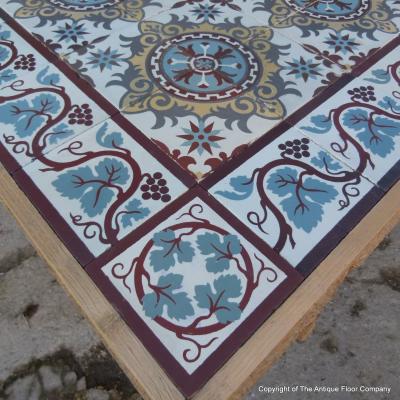A 10.75m2 antique French Maubeuge ceramic with its original borders
A ceramic encaustic floor manufactured by Produits de Ceramiques, Maubeuge, in the early twentieth century, consisting of a 15cm square field tile and its original same size border. The palette is warm, offering egg yolk yellow, green and burgundy on an off-white slip and the motif design stylized and navigational. The same sized grape-vine themed border tiles take from the same palette. We have only recovered one border tile corner but the border corners can be mitre cut from the regular border and we have shown how they will look in a mocked up computer graphic in the gallery.
The antique patina of the floor is beautiful, displaying subtle tonal variations evoking an individual handmade production.
In addition to the high resolution photographs of a random section of the floor we have also included a scan of the presentation of the tiles in the original Douzies Maubeuge catalogue in our possession.
The floor has cleaned well of its old lime based mortar and years of ingrained dirt and wax and the floor is in excellent condition, testimony to its original quality production.
Having being highly fired it can be laid inside or outside of the home as both high summer and sub zero winter temperatures will not present a problem in delivering a beautiful but robust and low maintenance floor.
Being excellent distributors of heat the tiles can be laid very effectively with underfloor heating systems.
The floor totals 10.75m2 / 116 sq ft.
Tile quantities by tile type (give or take one or two):-
FIELD - 400 tiles - 9m2 / 97 sq ft.
LARGE BORDERS - 80 tiles - 1.8m2 / 19.4sq ft or 12 linear metres / 39.4 linear feet
NOTE
Antique tiles were most commonly made in single or two tile moulds. Before current computer automation methods their moulds were made my hand and the colour slips mixed by eye. Kiln temperatures could also be variable, as could the firing time. The result is that often tiles display subtle size and thickness variations and there can be tonal variations in colours, owing to the slip mixing and/or firing time. All of this makes these handmade tiles unique and adds to their charm. Some floors display their subtle variations in size and tones, some not, but when photographing we always take a random section of the floor so that it is representative of the whole. A tiler should always dry lay a section of the tiles to familiarise himself with them before starting to fix lay.
MAD91 MAD102


























